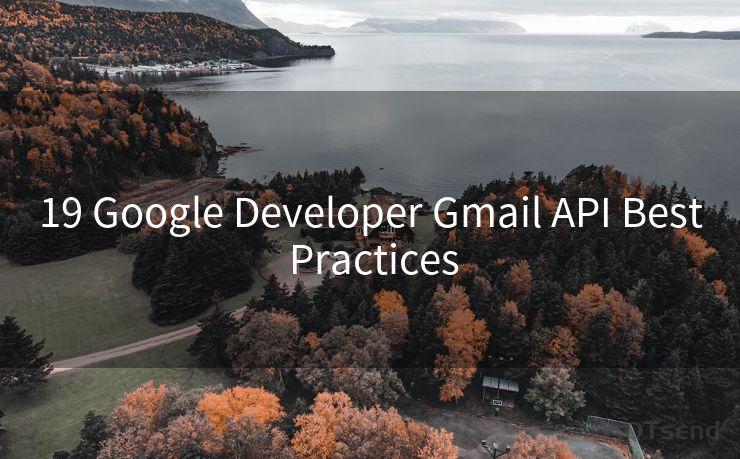19 Google Developer Gmail API Best Practices




When it comes to integrating with Gmail using the Google Developer Gmail API, following best practices is crucial for ensuring smooth and efficient operations. In this article, we'll explore 19 essential best practices that every developer should know when working with the Gmail API.
1. Understand the API Basics
Before diving into the specifics, it's important to have a solid understanding of the Gmail API's fundamentals. Familiarize yourself with the various endpoints, authentication methods, and data formats supported by the API.
2. Manage Authentication Properly
Authentication is a key aspect of working with the Gmail API. Ensure that you are using OAuth 2.0 for authentication and that your application handles token expiration and refresh gracefully.
3. Optimize Your Requests
To minimize latency and maximize efficiency, optimize your API requests. Use batch requests to fetch multiple resources in a single API call, and paginate your results to avoid fetching unnecessary data.
4. Handle Errors Gracefully
The Gmail API may return errors due to various reasons, such as invalid requests or rate limiting. Implement robust error handling mechanisms to ensure your application can recover from such scenarios.
5. Utilize Labels and Filters
Gmail's labeling system is a powerful tool for organizing and retrieving emails. Leverage labels and filters to categorize and search for specific emails efficiently.
6. Monitor and Manage Quotas
The Gmail API has usage limits to prevent abuse. Monitor your API usage and implement strategies to avoid hitting these quotas, such as caching results or spreading out requests over time.
7. Secure Your Data
When working with sensitive email data, security should be a top priority. Ensure that your application follows best practices for data encryption, secure storage, and transmission.
8. Implement Exponential Backoff
In case of temporary errors, such as network issues or server overloads, implement exponential backoff strategies to avoid flooding the API with requests.
9. Use the History API
The Gmail History API allows you to track changes to a user's mailbox. Utilize this feature to efficiently sync and update your application's state.
10. Optimize Data Retrieval
Retrieve only the data you need by specifying fields and using partial response functionality. This reduces bandwidth usage and improves performance.
11. Handle Attachments Carefully
When working with email attachments, be mindful of size limits and consider using resumable uploads for large files. Additionally, ensure proper handling of attachment metadata.
12. Utilize Webhooks
Implement webhooks (also known as push notifications) to receive real-time updates about changes in a user's mailbox, reducing the need for frequent polling.
13. Test in a Sandbox Environment
Before deploying your application, test it in a sandbox environment to ensure it functions as expected and to identify any potential issues.
14. Monitor Performance Metrics
🔔🔔🔔
【AOTsend Email API】:AOTsend is a Managed Email Service for sending transactional emails. Support Email Types: reminders, authentication, confirmations, notifications, verification codes, invoices, password resets, account activations, billing statements, two-factor authentication (2FA), and one-time passwords (OTP) emails, etc. $0.28 per 1000 Emails. 99% Delivery, 98% Inbox Rate.
You might be interested in:
Why did we start the AOTsend project, Brand Story?
What is a Managed Email API, How it Works?
Best 25+ Email Marketing Platforms (Authority,Keywords&Traffic Comparison)
Best 24+ Email Marketing Service (Price, Pros&Cons Comparison)
Email APIs vs SMTP: How they Works, Any Difference?
Regularly monitor key performance metrics such as latency, error rates, and API call volumes to ensure optimal performance and identify areas for improvement.
15. Keep Up with API Updates
The Gmail API is constantly evolving. Stay up to date with the latest changes and best practices by regularly checking the official documentation and release notes.
16. Use the Right Libraries and Tools
Utilize official Google libraries and tools, such as the Google APIs Client Library for your programming language, to simplify integration and reduce the chance of errors.
17. Respect User Privacy
Always respect user privacy and comply with relevant data protection regulations, such as GDPR, when handling email data.
18. Implement Logging and Monitoring

Implement robust logging and monitoring mechanisms to track API usage, identify bottlenecks, and troubleshoot issues efficiently.
19. Provide Feedback to Google
If you encounter any issues or have suggestions for improving the Gmail API, don't hesitate to provide feedback to Google. Your input can help shape the future of the API.
By following these best practices, you can ensure that your application integrates smoothly with the Gmail API, providing an optimal user experience while maintaining high performance and security standards. Remember, the key to successful integration lies in staying up to date with the latest API changes and best practices.




Scan the QR code to access on your mobile device.
Copyright notice: This article is published by AotSend. Reproduction requires attribution.
Article Link:https://www.mailwot.com/p5604.html



